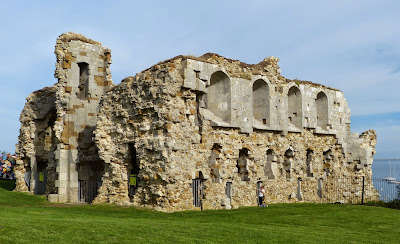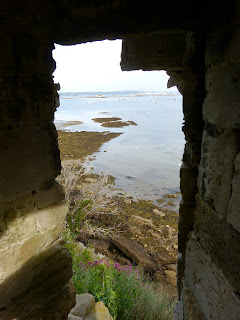 |
| Sandsfoot Castle |
On the cliff overlooking Portland Harbour, just a little way along the coast from Weymouth, stand the ruins of Sandsfoot Castle. The castle has been known by various names over the years – Weymouth Castle, Sandes Foot or Sandes Fort – but is now usually referred to as Sandsfoot Castle.
A Tudor blockhouse |
| Sandsfoot Castle from the Rodwell trail |
Sandsfoot Castle was built as a Tudor blockhouse during the reign of Henry VIII in c1539-41 to protect the south coast of England from European invasion after Henry’s break with Rome. Its position high up on the cliff would have made it very visible to approaching ships, forcing them to plot a course much closer to Portland. This would have put them in the firing line of Portland Castle, Sandsfoot’s sister castle, also built by Henry VIII, which would have been hidden until the ships were well into Portland Roads, that is, Portland Harbour.
The castle was governed by a series of governors and captains. It was part of the defensive network against the Spanish Armada and changed hands several times during the Civil War.
A Georgian visitor attraction
Sandsfoot Castle attracted artists and other visitors to its picturesque ruins, looking out over the sea. It was described in Delamotte’s The Weymouth Guide (1785):
The Lady’s Magazine (1789) wrote:
The later years
In 1665, when Humphrey Weld of Lulworth Castle was governor, the castle was removed from the military register. It was due to be slighted, that is, deliberately destroyed, to prevent it being used against the government, but for whatever reason, this never happened and the castle was simply abandoned.
What was the castle like? |
| View down to the beach from Sandsfoot Castle |
Sandsfoot consisted of a rectangular, two-storey accommodation block with a storage area in the basement, a tower on the west end and a gun platform on the eastern side, overlooking the sea. Earthworks and ditches were added later to protect the castle from inland attack. The castle walls contained a number of decorated pieces of stone which probably came from nearby Bindon Abbey, just east of Wool.
Sandsfoot Castle as a ruin |
| Model of Sandsfoot Castle in Weymouth Museum |
By 1725, Sandsfoot Castle had become a ruin. Since 1691, stone had been robbed from the walls for use elsewhere; some was probably used in the building of the Weymouth town bridge in 1712. The royal coat of arms carved in stone was removed from the castle in 1825 and is now over the south door of All Saints Church, Wyke Regis.
 |
| Royal coat of arms from Sandsfoot Castle in All Saints Church, Wyke Regis |
But the castle’s biggest enemy was the sea. Even during its active service, regular repairs had been necessary to prevent it falling into the sea, but once abandoned, nothing was done to protect it from its fate. In 1837, most of the gun platform collapsed onto the beach, but sea erosion slowed down after 1849 when the new Portland Harbour breakwater was created.
A Georgian visitor attraction
 |
| Weymouth Castle by S Prout from Picturesque Views on the South Coast of England (1826) |
“Weymouth Castle, called also Sandes Foot, or Sandes Fort, stands a miles S. W. of the town, on a high cliff, almost opposite Portland Castle, and commands the Bay. It was built by King Henry VIII. Leland calls it “a right goodly and warlyke castle, having one open barbicane”. Its form is a parallelogram, or long square, and was faced with square stone, now all carried away. At the north end was a tower, on which were the arms of England, supported by a wyvern and unicorn: the north part seems to have been the Governor's apartment, which is all vaulted; the south front is semicircular, and said to have been the gun room: before it, on the south, was formerly a platform for cannon. On the east is the remains of a small gate, and a deep trench surrounds the whole, except on the south: the walls were thick and lofty when entire; and though it was not large, must have been a beautiful structure. It seems to have been neglected since the Restoration. In 1631, George Bamfield had a grant of the office of Custos [ie Guardian] of Sandsfoot Castle, during pleasure: and in 1640, Nathaniel Speccot, Knight, was made Custos for life. After the restoration, Humphrey Weld, of Lulworth Castle, was Governor for many years.” (1)
 |
| Sandsfoot Castle from The Lady's Magazine (1789) |
Harvey’s Improved Weymouth Guide (1800) was more succinct:"Weymouth Castle, called also Sandes Foot, or Fort, stands a mile south-west of the town on a high cliff, almost opposite Portland Castle, and commands the bay. It was built by king Henry VIII. Leland calls it ‘a right goodly and warlyke castle, having one open barbicane’. Its form is a parallelogram, or long square stone, now all carried away. At the north end was a tower on which were the arms of England, supported by a wyvern and unicorn: the north part seems to have been the governor’s apartment, which was vaulted: the south front is semi-circular, and said to have been the gun-room: before it, on the south, was formerly a platform for cannon. On the east is the remains of a small gate, and a deep trench surrounds the whole, except on the south. The walls were lofty and thick when entire; and though it was not large, it must have been a beautiful structure. It seems to have been neglected since the Reformation." (2)
"At a small distance from hence is an old ruin called Weymouth, or Sandsfoot Castle, the remains of which are well worth seeing: from this Castle along the sands leading to the ferry house, when tide is out may be justly deemed a pleasing healthful excursion, it being quite level and as smooth as a bowling green." (3)
 |
| Part of Sandsfoot Castle showing some old graffiti |
In 1902, the castle was bought by the Weymouth Corporation for £150, but it had to be closed to the public in 1930 because the structure had become unsafe. Tudor style gardens were added in 1931 and in 1953 it became a Scheduled Monument and Grade II* Listed Building. The final part of the gun room collapsed in 1954.
The Castle was stabilised and repaired by the Friends of Rodwell Trail and Sandsfoot Castle in conjunction with Weymouth & Portland Borough Council and reopened to the public in 2012.
Notes:
(1) From The Weymouth Guide by Peter Delamotte (1785).
(2) From The Lady’s Magazine or Entertaining Companion for the Fair Sex, Appropriated Solely to Their Use and Amusement (1789).
(3) From Harvey's Improved Weymouth Guide (1800)
Sources used include:
Delamotte, Peter, The Weymouth Guide (1785)
Friends of Rodwell Trail & Sandsfoot Castle, Sandsfoot Castle (2014)
Harvey, John, Harvey's Improved Weymouth Guide (1800)
The Lady’s Magazine or Entertaining Companion for the Fair Sex, Appropriated Solely to Their Use and Amusement (1789)
Turner, JMW, Picturesque Views on the southern coast of England, from drawings made principally by JMW Turner and engraved by WB Cooke and others (1826)
Sandsfoot Castle and the Rodwell Trail website
Photographs © Andrew Knowles - More of Andrew's photos of Sandsfoot Castle on Flickr
 |
| Sandsfoot Castle with Portland Harbour in the background |
(1) From The Weymouth Guide by Peter Delamotte (1785).
(2) From The Lady’s Magazine or Entertaining Companion for the Fair Sex, Appropriated Solely to Their Use and Amusement (1789).
(3) From Harvey's Improved Weymouth Guide (1800)
Sources used include:
Delamotte, Peter, The Weymouth Guide (1785)
Friends of Rodwell Trail & Sandsfoot Castle, Sandsfoot Castle (2014)
Harvey, John, Harvey's Improved Weymouth Guide (1800)
The Lady’s Magazine or Entertaining Companion for the Fair Sex, Appropriated Solely to Their Use and Amusement (1789)
Turner, JMW, Picturesque Views on the southern coast of England, from drawings made principally by JMW Turner and engraved by WB Cooke and others (1826)
Sandsfoot Castle and the Rodwell Trail website
Photographs © Andrew Knowles - More of Andrew's photos of Sandsfoot Castle on Flickr

at that it faired better than Henry VIII's fort at Felixtowe, which was built on the ruins of the Roman fort there, I believe, and is now a shipping lane to the Hook of Holland.
ReplyDeleteSarah Waldock on the wrong computer
We are very fortunate that Sandsfoot is still standing. It was also fortunate that the coat of arms was removed and put inside All Saints Church in 1825 as this means it has been preserved whereas those left in situ have been worn away.
Delete